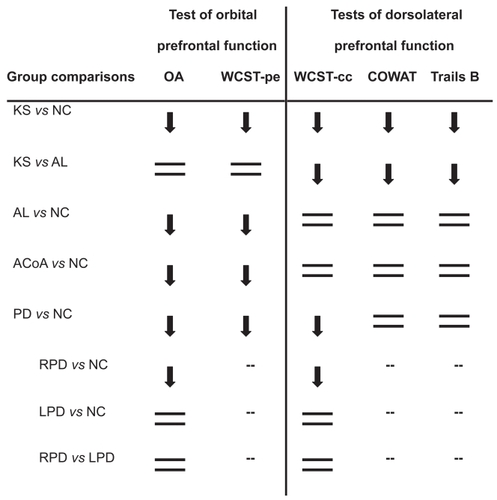Figures & data
Table 1 Means and standard deviations for for age, educational level, Wechsler Adult Intelligence Scale (WAIS-III) Full Scale IQ (FSIQ), Wechsler Memory Scale (WMS-III) General Memory Quotient (GMQ), and Mini Mental State Exam (MMSE) score. The comparison groups consist of healthy Control participants, non-Korsakoff alcoholics, and patients with alcoholic Korsakoff’s syndrome
Table 2 Means and standard deviations for healthy control participants and patients with Parkinson’s disease (PD) for age, educational level, Mini Mental State Exam (MMSE) score, Wechsler Adult Intelligence Scale (WAIS-III) Full Scale IQ (FSIQ), and Wechsler Memory Scale (WMS-III) General Memory Quotient (GMQ)
Table 3 Healthy non-neurological control participants are compared with patients with rupture and repair of the anterior communicating artery (ACoA). Group means and standard deviations are provided for age, educational level, Mini Mental State Exam (MMSE) score, Wechsler Adult Intelligence Scale (WAIS-III) Full Scale IQ (FSIQ), and Wechsler Memory Scale (WMS-III) General Memory Quotient (GMQ)
Figure 1 Group patterns of dorsolateral prefrontal and orbitofrontal function relative to non-neurological control (NC) participants, except where noted (— indicates that post hoc tests were not carried out, because the group main effect of the ANOVA was not significant). Downward arrows indicate observed deficits, and equal signs indicate absence of deficits. The groups consisted of Korsakoff patients (KS), non-Korsakoff alcoholics (AL), patients with rupture and repair of the anterior communicating artery (ACoA), and patients with Parkinson’s disease (PD), including subgroups of PD patients with right-side motor symptom onset (RPD) or left-side motor symptom onset (LPD).

Table 4 Means and standard deviations by group for number of errors on Object Alternation (OA), percentile score on perseverative error measure of the Wisconsin Card Sorting Test (WCST-pe), number of categories completed on the Wisconsin Card Sorting Test (WCST-cc), total number of words generated on the Controlled Oral Word Association Test (COWAT), and total number of errors on Trails B